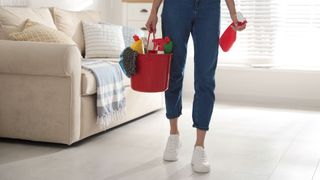Luckily, vinyl is water-resistant, so you don’t have to be cautious about using wet cleaning methods. This is also great news for those who are prone to spillages, as you won’t have to act as quickly when glasses are knocked over. Manufactured from PVC, vinyl is resilient and easy to clean, which is why it’s a firm favorite for those with pets and children. As well as providing plenty of functional qualities, it comes in many different patterns that replicate natural materials, enabling you to create a stylish interior without breaking the bank. To keep your floors looking stylish, and not sticky, we’ve put together some guidance on how to clean vinyl floors and tackle stubborn stains. While there are many natural and chemical solutions available, we recommend vacuuming regularly with one of the best vacuum cleaners (opens in new tab) to keep on top of dust and grime.
How often you should clean vinyl floors
High-traffic areas will mean that you’ll need to clean more frequently to avoid grime building up. Increased footfall in hallways, kitchens, dining rooms and bathrooms will mean that dust will accumulate pretty quickly – especially if you wear shoes in the home. The best robot vacuums (opens in new tab) are a particularly easy way to regularly remove dirt and debris from vinyl flooring, but sweeping is also very effective. This will limit the amount of deep cleaning required, saving time and effort. Deep cleans, including stain removal, should be assessed on a case-by-case basis. For some households with pets and children, vinyl floors will quickly become sticky and muddy, so cleaning weekly with either regular mops or the best steam mops (opens in new tab) may be necessary. Others with quieter households may manage with thorough cleaning less often, instead opting to scrub as and when floors look mucky.
What you should use to clean vinyl floors
Vinyl is simple to clean with natural methods, so keeping mild detergents stocked in your kit will be more than good enough to tackle dirt. Resist the temptation to tackle vinyl floors with heavy-duty chemical cleaners. While vinyl isn’t as sensitive to damage as stone surfaces, mild cleaning solutions will do the trick just as well. They’re also a safer option for using around animals, so you can clean without worry.
How to remove stains from vinyl floors
Vinyl is often favored for high traffic areas such as bathrooms and kitchens. as it stands up well to heavy footfall. However, this doesn’t mean it’s completely resistant to staining. The good news is that you can bring vinyl floors back to their original condition using basic household cleaners. At home methods will easily cut through stubborn grease, grime, and even embedded stains. Before getting started, you should distinguish what the composition of the stain is. Most marks can be remedied with a simple baking soda and white vinegar paste, however rubbing alcohol is better when it comes to makeup and ink. Prior to getting started with the following steps, we always recommend testing any cleaning methods on an inconspicuous patch of floor. Trying products on an area underneath a rug or furniture will mean that if anything goes awry, the impact is minimal.
How to clean stains with baking soda and vinegar
Baking soda and vinegar are often considered the holy grail of cheap and mild cleaning products. Use the instructions below to help remove stubborn stains from your vinyl floor.
How to clean stains with rubbing alcohol
Rubbing alcohol can also be a good way to remove stains from vinyl flooring.
Top tips to keep vinyl floors looking their best
The best way to keep your vinyl floors clean is to avoid dirt from entering the home and protecting your vinyl floor from any potential damage from the start. As well as noting down ways to clean stains, follow these accessible tips to keep your vinyl floors looking good as new. Discover more guides for the home… Best top load washers (opens in new tab) Best dishwashers (opens in new tab) Best dryers (opens in new tab) Best robot vacuums (opens in new tab)









